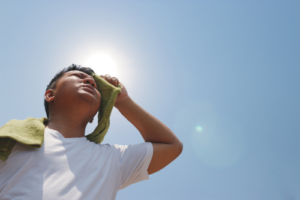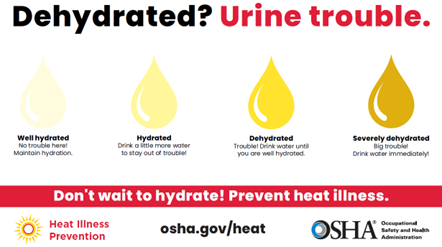Beat the Heat: Understanding and Preventing Heat Stress
Guest post by Olivia Bontems, LMCIT loss control consultant
As we enter the hottest periods of summer, it’s vital for all of us—regardless of our roles—to be aware of the risks associated with heat exposure.
Understanding Heat Stress
Heat stress occurs when our bodies struggle to cool down enough to maintain a healthy temperature. Several factors contribute to heat stress, including:
- High outdoor temperature
- Layers of clothing/personal protective equipment (PPE)
- High humidity
- Direct sunlight
- Intensity of work
- Non-air-conditioned workspaces
Understanding these contributing factors is essential for proactively managing and preventing heat stress in the workplace. Heat stress can lead to various health issues, ranging from mild discomfort to severe conditions like heat exhaustion or heatstroke. Identifying the signs and symptoms early is crucial for prevention.
Recognizing the Signs
Dehydration
The color of one’s urine can be a gauge of hydration levels. Adequate hydration is crucial for keeping our organs functioning optimally and supporting overall health and well-being.

Heat Cramps
Painful muscle cramps can occur during or after working in a hot environment, often affecting overexerted muscles.
Heat Exhaustion
Heat exhaustion is the body’s response to an excessive loss of water, salt, or both. Left untreated, it can progress to heat stroke. Symptoms include excessive sweating, weakness, nausea, and dizziness.
Heat Stroke
Heat stroke is the ultimate breakdown of the body’s temperature control system, leading to a rapid rise in body temperature. It can be life-threatening and requires immediate emergency treatment. Symptoms include fainting, high body temperature, a headache, lack of sweating, vomiting, and confusion.
Tips to Prevent Heat Stress:
- Drink plenty of water throughout the day, even if you don’t feel thirsty. Avoid excessive caffeine and sugary drinks.
- Wear lightweight, loose-fitting, and light-colored clothing to reflect the sun.
- Schedule regular breaks in shaded or cool areas. Allow your body to recover from the heat.
- Plan strenuous tasks for cooler parts of the day, if possible.
- Use sunscreen, wear a wide-brimmed hat, and use sunglasses to protect yourself from the sun’s harmful rays.
- Encourage a culture of looking out for one another. If you notice a colleague showing signs of heat stress, act promptly. Ensure everyone is aware of the importance of recognizing and addressing heat-related issues.
For more information about protecting your staff from heat-related illnesses and injuries, please contact your LMCIT loss control consultant. If you aren’t sure who to contact, please email Olivia Bontems at [email protected].
View more OSHA heat illness prevention guidelines and resources.

